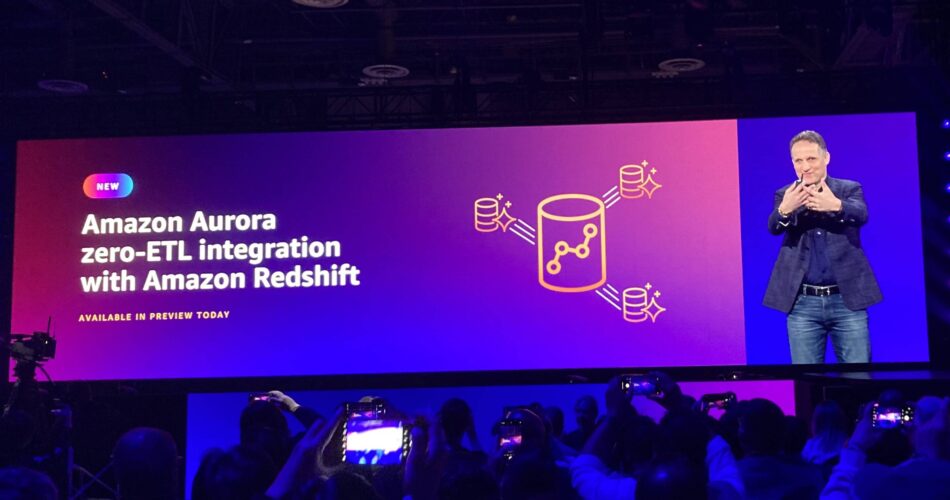RE:INVENT AWS CEO Adam Selipsky promised a “zero ETL future” in his re:Invent keynote on Tuesday in Las Vegas, introducing new integration between the Redshift data warehouse service and the Aurora relational database service.
Zero-ETL, now in preview, lets users link Aurora data from multiple clusters to a Redshift instance, to achieve what AWS describes as “near real-time analytics and machine learning.” ETL (Extract, Transform, Load) of relational data to a data warehouse can be arduous to develop and keep up to date.
Other announcements included a serverless version of OpenSearch (the search service derived from Elasticsearch); Amazon Security Lake, for analytics against data using the cross-vendor OCSF (Open Cybersecurity Schema Framework) format; SimSpace Weaver, for “massive spatial simulations”; new instance types for data-intensive HPC and for machine learning inference; Amazon Supply Chain; AWS Clean Rooms for exchanging customer data between partners while protecting privacy; and Amazon Omics for analyzing genomic data.
The keynote was steady, but lacking in breakthrough news and somewhat slow-moving, causing AWS watcher and cloud economist Corey Quinn to declare that “to say I’m disappointed by this keynote is a significant understatement.”
This is the 11th AWS re:Invent, with 50,000 attendees according to CEO Selipsky, who is in his second year since taking over the role from Andy Jassy. The event is huge, with sessions across six cavernous Las Vegas hotel casinos, yet not quite back to 2019 numbers, when around 60,000 showed up.
Selipsky is politer than his predecessor and we did not get anything like Jassy’s rants against Oracle or Microsoft, though he did declare that Aurora is “the fastest growing service in history of AWS” and “1/10 the cost of commercial databases,” causing one to reflect on the still uneasy relationship between AWS and open source. Aurora is based on the open source MySQL and PostgreSQL but with storage optimization that improves performance.
A problem for AWS at re:Invent is that there are multiple keynotes across the five days and it may be challenging to find enough big news to spread across all of them. There was little logic in having Senior VP Peter de Santis introduce some new EC2 (Elastic Compute Cloud) instance types yesterday while Selipsky presented others today, for example. Selipsky also took attendees on journeys into space, into undersea exploration, and across the Antarctic with Scott and Amundsen; opportunities to present some stunning images but still perhaps more filler than content.
Some of today’s news is more in the realm of solutions than new technology, things like AWS Omics or AWS Supply Chain, now in preview, which “helps supply chain leaders mitigate risks and lower costs to increase supply chain resilience.”
AWS is gradually and inevitably moving up the stack from building blocks to complete applications, and along the way competing with more of its partners. But this is less compelling than past innovations such as Lambda serverless, or Nitro virtualization, or Graviton Arm processors, each of which proved to be breakthrough technologies.
“AWS Supply Chain. boom. The next few billion dollars of revenue. AWS sells apps, not just infrastructure. Buyers, not builders. The change has been coming, but this feels like the gloves coming off for much more direct competition with B2B software/cloud companies,” remarked Redmonk analyst James Governor.
Towards the end of today’s keynote Selipsky referenced the “just walk out” technology which lets shoppers walk into a grocery store and walk out with their purchases without the inconvenience of checkout tills and how a palm recognition service called Amazon One is reducing the need for standing in line. Perhaps it is; but it raised wry smiles at an event characterized by endless queuing.
Despite the lack of breakthrough technology announcements, services such as Zero ETL integration address real pain points and enterprise AWS customers will be happy with the cloud giant’s progress. ®



